North Ray (crater)
North Ray crater is a small crater in the Descartes Highlands of the Moon visited by the astronauts of Apollo 16. The name of the crater was formally adopted by the IAU in 1973.[1] It is the largest crater sampled by astronauts during the Apollo program.
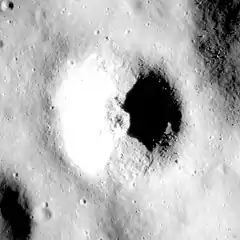 Apollo 16 image | |
| Coordinates | 8.82°S 15.48°E |
|---|---|
| Diameter | 950 m[1] |
| Depth | 240 m |
| Eponym | Astronaut-named feature |
The Apollo 16 Lunar Module (LM) Orion landed between North Ray and South Ray craters on April 21, 1972. The astronauts John Young and Charles Duke explored the area between the craters over the course of three EVAs using a Lunar Roving Vehicle, or rover. They visited North Ray on EVA 3, at station 11, about 4.4 km north of the landing site. On the way, they drove along the rim of the similar sized but older crater Palmetto, which is approximately 3 km south of North Ray.
North Ray crater is approximately 1 km in diameter and approximately 240 m deep.[2] The astronauts observed that the upper 50 m of the slope is gentle, but that it becomes steep below 50 m, and they could not observe the bottom. The inner slopes are covered by boulders up to 5 m across. A huge (10 m high x 20 m long) boulder, known as House Rock, lies near the southeastern rim. A smaller boulder that is almost certainly a fragment of House Rock is officially known as South Boulder, but unofficially known as Outhouse Rock.[3] The ray system, which can be seen from orbit, was not obvious on the ground.
North Ray cuts into the Cayley Formation of Imbrian age,[4] but the crater itself is much younger, of Copernican age, based on the presence of rays. (See also section on age below.)


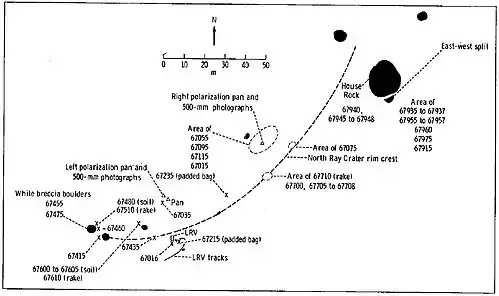
Age

Based on sample 67955,[5] a noritic anorthosite collected from Outhouse Rock, the impact that created North Ray crater was about 50 million year ago. This is based on the measured duration of the rock's exposure to cosmic rays.[6] The rock itself is dated at 4.20 ± 0.07 b.y. by Sm/Nd radiometric dating.[7]
Samples
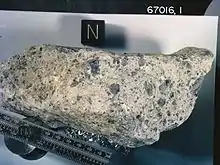
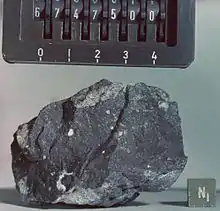
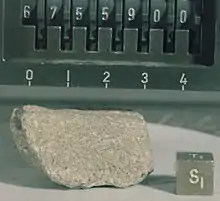
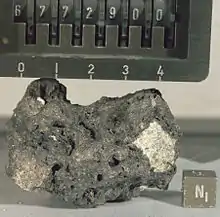
The following samples were collected from North Ray Crater (Station 11), as listed in Table 6-II of the Apollo 16 Preliminary Science Report,[3] which does not include samples smaller than 25 g weight (of which there were many). Sample type, lithology, and descriptions are from the Lunar Sample Atlas of the Lunar and Planetary Institute.[8]
| Sample | Sample Type | Lithology | Description |
| 67015 | rake | breccia | Fragmental matrix breccia, mostly feldspar, but with a wide range of highland lithologies represented as loose clasts in the matrix; have been dated at 3.9 b.y. and the breccias, itself, has had an exposure to cosmic ray of 51 m.y. |
| 67016 | rock | breccia | Feldspathic fragmental breccia with both light and dark clasts, and is 3.95 b.y. old with an exposure age of 50 m.y. |
| 67035 | rock | Fragmental breccia | Very friable, light matrix breccia; was found to be 3.95 b.y. |
| 67055 | rock | breccia | Black and white breccia; high trace element content, but has not been dated. |
| 67075 | rock | anorthite | Lunar sample 67075 is very friable. Detailed petrographic description showed that the sample may be a mixture of closely related anorthositic rocks from a layered igneous intrusion, and it has been shown to be 4.47 b.y. old, with about 50 m.y. exposure to cosmic rays |
| 67095 | rock | impact melt breccia | A glass-coated basaltic impact melt or "bomb" that has not been dated. |
| 67115 | rake | breccia | Glass coat is rather thick, but has been fractured and broken off by micrometeorite bombardment |
| 67210 (67215) | rake | breccia | White polymict breccia made up of mostly calcic plagioclase and a few relict lithic clasts and has many zap pits on top and bottom |
| 67230 (67235) | rock | impact melt breccia | 67235 is a large special sample that was collected to study the outer surface of a lunar rock |
| 67415 | rake | breccia | According to Lindstrom and Lindstrom (1986), 67415 is a lightly-shocked, granulitic breccia with a cataclastic matrix. |
| 67435 | rock | breccia | Grey matrix breccias with both dark and light clasts |
| 67455 | rake | breccia | Very friable, white polymict feldspathic breccia |
| 67475 | rake | breccia | A tough purplish-grey, glassy breccia |
| 67515 | rake | breccia | Friable, chalky white rock containing lithic fragments of cataclastic anorthosite and feldspathic granulite |
| 67549 | rake | breccia | Porous and rounded with a light matrix and both light and dark clasts |
| 67556 | rake | breccia | A friable micropoikilitic impact melt with intrusive glass veins. It has a micrometeorite crater. |
| 67559 | rake | basalt | Igneous texture indicating that it cooled from a liquid, albeit, highly aluminous. It contains a trace of Ni, Ir and Au and has been dated at 3.76 ± 0.04 b.y., which makes it a critical sample. |
| 67605 | rake | breccia | Relatively large friable, white particle about the size, shape and color of a golf ball |
| 67627 | rake | breccia | Glass-cemented aggregates |
| 67628 | rake | breccia | Glass bombs (renumbered to 4 separate samples 67685-67688) |
| 67629 | rake | breccia | Glass-cemented aggregates (renumbered to 4 separate samples 67629, 67695, 67696, 67697) |
| 67647 | rake | breccia | Relatively coherent with many zap pits and has glass clasts, and glass in the matrix |
| 67718 | rake | breccia | Abundant clasts of plagioclase set in an aphanitic matrix |
| 67729 | rake | breccia | Vesicular glass breccia with significant clasts, and has the appearance of a "glass bomb". It has zap pits on all sides |
| 67915 | rock | breccia | Composed of white and grey breccias; both are polymict (Taylor and Mosie 1979), cemented by shock-melted glass and is also cut with thin black glass veins |
| 67935 | rock | breccia | Thin veins of black glass, texture of fine-grained subophitic basalt |
| 67936 | rock | breccia | Thin veins of black glass, texture of fine-grained subophitic basalt |
| 67937 | rock | breccia | Thin veins of black glass, texture of fine-grained subophitic basalt |
| 67955 | rock | breccia | Exterior surface has a thin brown patina with micrometeorite pits; has been dated at 4.2 b.y. with exposure to cosmic rays for ~ 50 m.y. (age of North Ray Crater) |
| 67975 | rock | fragmental breccia | Irregularly shaped rock with approximately equal amounts of pale gray, fragmental, friable breccia and a coating of frothy, clast-rich glass. |
External links
- Geology of North Ray Crater, Section D2 of Geological Survey Professional Paper 1048, by George E. Ulrich. 1981.
- Apollo 16 Traverses, 78D2S2(25), Lunar and Planetary Institute
References
- North Ray, Gazetteer of Planetary Nomenclature, International Astronomical Union (IAU) Working Group for Planetary System Nomenclature (WGPSN)
- Apollo 16 Landing Area, 78D2S1(50), NASA Lunar Topophotomap. Published by The Defense Mapping Agency, November 1974. Available from Lunar and Planetary Institute.
- Apollo 16 Preliminary Science Report (NASA SP-315), 1972
- Geologic Map of the Apollo 16 (Descartes) Landing Area by Apollo Field Geology Investigation Team (D. P. Elston, E. L. Boudette, J. P. Schafer), United States Geological Survey, April 1972
- 67955 Summary Sheet available from Lunar and Planetary Institute
- Drozd R.J., Hohenberg C.M., Morgan C.J. and Ralston C.E. (1974) Cosmic-ray exposure history at the Apollo 16 and other lunar sites: lunar surface dynamics. Geochim. Cosmochim. Acta 38, 1625-1642.
- Norman M.D., Shih C.-Y., Nyquist L.E., Bogard D.D. and Taylor L.A. (2007) Early impacts on the moon: Crystallization ages of Apollo 16 melt breccias (abs#1991). Lunar Planet. Sci. XXXVIII Lunar & Planetary Institute, Houston. (LPSC 2007 web page)
- Lunar Sample Atlas, Lunar and Planetary Institute